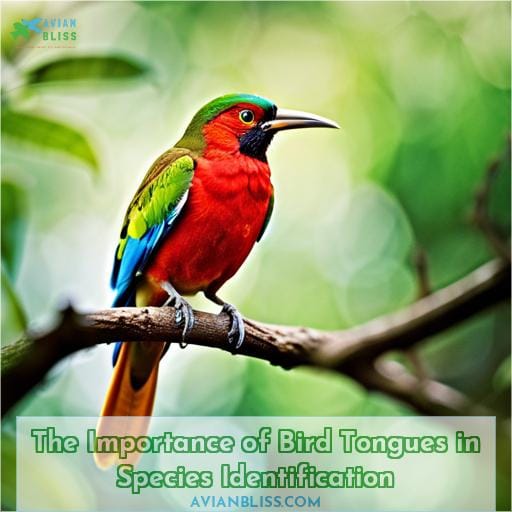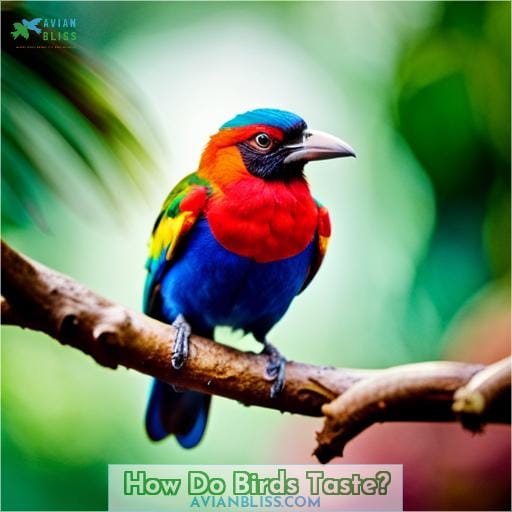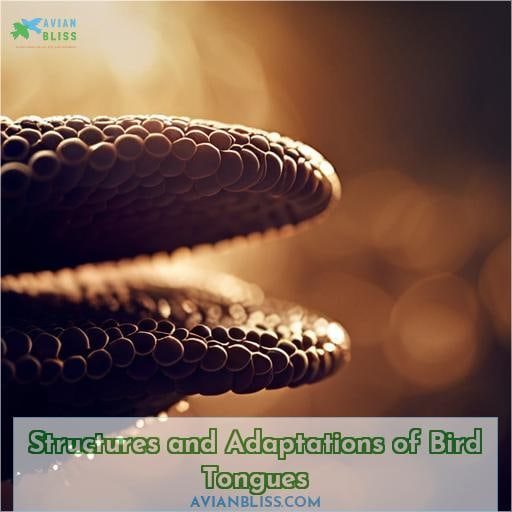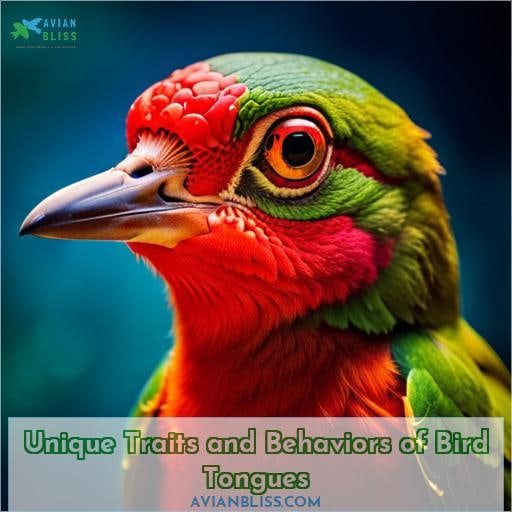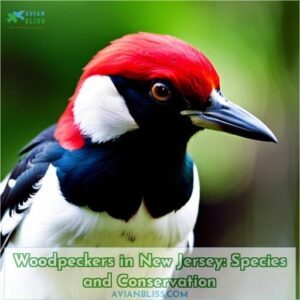This site is supported by our readers. We may earn a commission, at no cost to you, if you purchase through links.
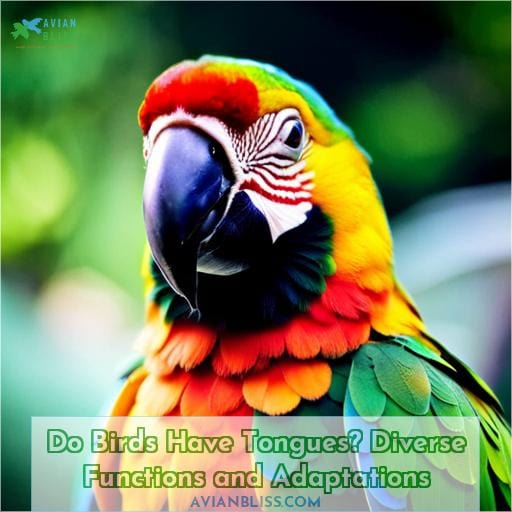 Beginning with a question, have you ever considered whether birds have tongues? As it turns out, all species of birds do possess tongues! Though these avian wonders come in an array of shapes and sizes to suit specific needs for consuming food and even communication.
Beginning with a question, have you ever considered whether birds have tongues? As it turns out, all species of birds do possess tongues! Though these avian wonders come in an array of shapes and sizes to suit specific needs for consuming food and even communication.
From the long retractable tongue used by woodpeckers to capture insects deep inside tree trunks, to the small almost redundant tongue found on flightless species like emus or ostriches – bird tongues are truly remarkable adaptations.
Even more impressive are their barbed edges designed for gripping onto prey items, lingual nails which help parrots crack open nuts and seeds as well as salivary glands that moisten food while providing antibacterial function.
In essence, they provide a unique way for us humans to appreciate how incredibly diverse our feathered friends can be!
Table Of Contents
- Key Takeaways
- The Importance of Bird Tongues in Species Identification
- Diverse Functions of Bird Tongues
- How Do Birds Taste?
- Tongue Varieties for Specific Purposes
- Structures and Adaptations of Bird Tongues
- Birds’ Tongues and Sound Modification
- Unique Traits and Behaviors of Bird Tongues
- Quotes and Call to Action
- Personal Connection and Further Engagement
- Conclusion
Key Takeaways
- Birds possess diverse tongue adaptations for specialized feeding and communication.
- Tongues play critical roles in survival and adaptation.
- Birds’ tongues have taste buds for detecting flavors.
- Birds’ tongues showcase adaptation, survival, and diversity.
The Importance of Bird Tongues in Species Identification
You feel the rapid tap tap tap of the woodpecker’s extended tongue on your window as you spot its unique markings and realize this helps identify the species. As an amateur ornithologist, you know a bird’s tongue holds important clues for identification.
The shape, length, spines, barbs, and papillae all indicate adaptations for specialized feeding behaviors. For instance, nectar-feeding hummingbirds have tubular tongues, while seed-cracking parrots possess a keratinous lingual nail.
Thrushes use flat wide tongues to capture insects, and pelicans have accessory tongues to help scoop fish.
Closely observing a bird’s tongue structure reveals its lifestyle and taxonomy. So when that acorn woodpecker comes knocking, check out its barbed tongue snatching insects, adding another confirmed sighting to your life list.
Avian linguistics aids classification, enriching your birding passion.
Diverse Functions of Bird Tongues
Let’s explore the diverse functions of bird tongues. Woodpeckers and hummingbirds use extended, specialized tongues to probe flowers and bark. Filter-feeding birds like flamingos have complex, papillae-covered tongues for filtering tiny food particles, while geese employ their tongues and bills to clip vegetation.
Penguins and mergansers have spiny tongues to help grab slippery fish, and parrots utilize their tongues to collect nectar and pollen. Some birds have rudimentary tongues just for swallowing large food, and nestlings often have marked tongues that aid in feeding by parents.
Woodpeckers and Hummingbirds
Woodpeckers possess incredibly long, sticky tongues that can extend up to four times their bill length. These allow them to probe deep into holes and crevices to expertly extract insects.
Hummingbirds have specially adapted grooved tongues that allow them to lap up nectar at high speeds.
Both unique tongue designs are supported by specialized hyoid bone apparatus in their skulls. This facilitates the tongue projection and retraction vital to their ecological roles.
Understanding these adaptations provides fascinating perspective on the tongue’s overlooked yet critical function in birds’ sensory experiences and survival strategies.
- Tongue extension and retraction
- Nectar extraction
- Insect capture
- Hyoid bone support
Filter-feeding Birds
Foraging on unique avian papillae-coated tongues enables specialized filter-feeding behaviors in flamingos, ducks, and other species. They utilize complex papillae to trap aquatic organisms. Intricate tongue features aid in feeding techniques.
Avian tongues exhibit adaptations for efficient filtration. Purposeful designs maximize nourishment extraction.
Geese and Vegetation Clipping
Scoop vegetation like a goose, clipping blades with its tongue for nourishment. Graze wetlands, acting like geese feeding on grass and weeds.
Penguins and Fish Capture
Dig for fish with the spines on your tongue as the Antarctic winds whip around you. Honed spines allow spearing slippery catches. An adapted beak aids in underwater feeding. Vocalizations connect you to your colony. Secrets of survival lie within your biology.
Nectar and Pollen Collection
You scrape the sweet nectar and juicy pollen with your tongue as lorikeets and parrots collect up to several ounces of food each day. Their specialized lingual papillae efficiently trap floral rewards while maintaining vital plant relationships, though sometimes competing with bees.
Rudimentary Tongues for Swallowing
Look deeper to see that some birds possess tongues that are quite rudimentary for easily swallowing food whole.
- Pelicans
- Herons
- Spoonbills
- Ibises
These groups have evolved muscular tongues and a hyoid apparatus that allows for efficient swallowing of large prey. Their tongues lack intricate structures that enable complex food manipulation. The simple design of their tongues permits the quick passage of sizable meals into their digestive tracts.
Although limited in finesse, such tongues display a wonderful diversity in bird swallowing mechanisms.
Marked Tongues in Nestlings
Won’t you melt just seeing those marked little tongues in the nest, begging for food from mama bird? Those designs aid parental feeding. Vibrant colors and varied patterns guide nourishing crop milk. Young tongues adapt, aiding development.
Parrots and Sound Modification
Y’all have gotta hear how parrots transform sounds with their tongues.
- Mimicking human speech
- Imitating environmental sounds
- Altering pitch and tone
Parrots expertly modify sounds using their syrinx anatomy and tongue acrobatics for vocal mimicry. Although all birds vocalize with their syrinx, parrots uniquely harness cranial kinesis and tongue movement to articulate words.
Their sticky tongues, moved by specially evolved muscles, dramatically impact the sounds produced in their syrinx. This vocal mastery gives parrots the ability to mimic human speech and sounds in their environment.
How Do Birds Taste?
You’ve got bird taste buds that help find worms and flavors. Birds have taste buds like humans do, though they differ in number and distribution.
- Fungiform taste buds on tongue tips detect sweetness.
- Foliate taste buds along tongue sides sense savory flavors.
- Circumvallate taste buds near the back perceive bitter tastes.
- Ultimate taste buds in the palate detect sourness.
Your tongue’s saliva keeps food moist and has enzymes to start digestion. Unique receptor cells signal your brain when specific flavors are present, like worms under sand.
Sophisticated bird tongues play a critical role in health, adaptation, and survival across diverse environments and food sources.
Tongue Varieties for Specific Purposes
Let’s explore the fascinating varieties of bird tongues adapted for specific purposes. Woodpeckers have long, sticky tongues to snatch insects; parrots’ flexible tongues aid in cracking seeds and speech mimicry; vultures and eagles use grooved tongues to extract marrow from bones; pigeons and flamingos employ piston tongues for efficient drinking; hummingbirds have tubelike tongues for nectar feeding; ducks possess a lingual nail for grasping grains; flightless birds also have tongue traits suited to their ecological niches and feeding behaviors.
Woodpeckers and Insect Capture
You’ll feel your heart flutter when you see a woodpecker’s barbed tongue dart out and snatch an insect. This sticky tongue with rear-facing barbs enables efficient capture of ants, beetles, and other insects from deep crevices.
Specialized muscles allow rapid extension and retraction of the tongue, providing a key adaptation for this insectivorous bird’s survival. Unique modifications like these reveal nature’s ingenuity in equipping each species for securing nutrition vital to sustaining life.
Parrots and Seed Consumption
The flexibility of parrots’ tongues lets them twist them every which way for gobbling up seeds faster than a tornado in a trailer park. Their tongues adapt to the many sizes and shapes of seeds, letting them crack open shells and extract the nutritious goodness within.
Parrots developed these flexible tongues over eons to capitalize on seasonal abundance. Their tongues are conduits connecting Earth’s bounty to parrots’ survival. Witnessing parrots employ their tongues illuminates nature’s ingenuity.
Parrots inspire us to nurture our own adaptability. Flexibility empowers prosperity.
Vultures and Marrow Extraction
Your grappling groove glides over grooved tongues, grabbing gobbets.
- Sharp barbs
- Powerful muscles
- Bone scraping
With keratinous spikes and sensory papillae, vultures use their tongues to rip and extract marrow from carrion bones. The rugged edges on the tongue easily slice into the softer marrow. Strong jaw muscles support the tugging action to scrape every morsel out.
Horny spikes hook and pull strings of marrow while taste buds carefully test each gobbet. This scavenging style allows vultures to fully utilize animal remains in their niche. Using unique adaptations, these birds of prey unleash the true potential of their tongues.
Pigeons and Flamingos for Drinking
Tip your beak back and stretch your feathered piston tongue to gulp a cooling drink. A unique drinking apparatus enables thirsty pigeons to pump water using their tongues. Flamingos filter refreshment from the lake, tongues laden with algae. Like straws, avian tongues adapt for hydration.
Hummingbirds and Nectar Feeding
Humming away on that sweet nectar, your freakish tube tongue dives deep into each flower.
- An extendable tube-like tongue with tiny hair-like structures to lap nectar.
- Specialized rapid lapping and retracting motions to collect small volumes.
- Trapping nectar within twin fringed tubes while probing flowers.
With such remarkable hummingbird tongue designs and behaviors, these small avian nectar-feeders exemplify the amazing diversity of tongues in the bird world.
Ducks and Grasping Grains
You’re snatching up grains with your weird tongue, ducky. Tongues of ducks like Cinnamon Teal have lingual nails for grasping grains. Ducks utilize tongue adaptations and techniques to forage grains. Their lingual features assist in grain collection.
Flightless Birds
Flightless Birds
Your tongue’s limitations reflect your incapacity to fly.
| Flightless Species | Tongue Adaptations |
|---|---|
| Ostrich | Small tongue, use beak more |
| Cassowary | Small tongue, scrape fruit |
| Kiwi | No tongue, use long beak |
| Penguin | Barbs to hold fish |
| Emu | Reduced tongue, swallow food whole |
The tongue plays a crucial role in eating, yet flightless birds rely more on their beaks.
Structures and Adaptations of Bird Tongues
There are some fascinating structures and adaptations found in bird tongues. Tiny papillae cover tongues with digestive enzymes for trapping and breaking down food. Serrated or barbed edges on certain tongues grip prey. Salivary glands keep tongues moistened while providing antibacterial functions.
Astoundingly, the Northern Flicker woodpecker has a tongue that can extend over twice the length of its bill.
Papillae and Enzymes
You have subtle papillae with enzymes for subtly trapping and digesting your food. Covered in complex chemical sensitivities, your advanced papillae harness nature’s alchemy for sustenance. Banquet upon bird tongues containing microscopic feathered instruments, performing instinctive gustations.
Within each fowl gullet, there is an intricate biology enabling life’s nourishment.
Barbed Edges for Gripping
You see some birds have serrated and barbed edges on their tongues that grab and grip food. Different species have evolved unique tongue structures for feeding strategies adapted to their environments.
Serrated tongues aid certain birds in capturing slippery prey like fish or firmly gripping insects. The variation in avian tongue anatomy demonstrates incredible adaptation for specialized feeding techniques.
Tongue evolution has shaped distinct gripping tools that empower each species’ feeding success. Though diverse, all tongues serve the critical functional role of procuring sustenance.
Salivary Glands for Moistening and Antibacterial Function
You would notice their moistening and antibacterial salivary glands. These glands lubricate tongues and help extract food. Saliva keeps tongues moist for feeding, while its antibacterials prevent infections.
Extraordinary Tongue Length in Northern Flicker Woodpeckers
Wonderingly witness woodpeckers’ wondrously whiplike worm-wrangling waggling tongues. Northern Flicker adaptations showcase remarkable woodpecker tongue anatomy. Evolved for avian feeding techniques, their extended tongues delve deep into crevices, aided by salivary gland functions.
Birds’ Tongues and Sound Modification
Explore the realm of avian vocal artistry as intricate internal structures collaborate to mold ethereal melodies and resonant calls, showcasing how these remarkable creatures craft their symphonies from within.
At the heart of this acoustic marvel lies the syrinx, a complex vocal organ nestled where the trachea splits into the lungs. Tongue resonance and syrinx complexity intersect, shaping the unique tones emitted by birds.
But it’s not just the syrinx that contributes to their vocal adaptations. Beak sound modification also plays a role, as birds can adjust the shape of their beaks to alter sound frequencies.
Evolutionary voice changes are evident in various species. Parrots, renowned mimics, exhibit incredible control over their syrinx and beak, enabling them to replicate sounds with astonishing precision.
From the haunting melodies of the common loon to the intricate warbles of songbirds, each species has honed its vocal prowess to communicate, attract mates, and establish territory.
Understanding these adaptations fosters a deeper connection with the avian world, illuminating the intricate interplay between anatomy and artistic expression.
Unique Traits and Behaviors of Bird Tongues
Delving further into the intricate world of avian tongues, you’ll uncover remarkable adaptations that set certain bird species apart. Parrots, for instance, possess a unique keratin lingual nail perfectly evolved for deftly scooping seeds—a trait that showcases the ingenious diversity of tongue functionality.
Observing crows utilizing their tongues to transport food to their nestlings offers a glimpse into the multifaceted roles these structures play in avian life. The discerning eye can readily distinguish distinctive characteristics within the tongues of sparrows and pigeons, accentuating the diversity among these common yet intricate creatures.
Moreover, these adaptations in tongue structure and function align harmoniously with the avian reliance on gizzards, underlining the evolutionary necessity of specialized digestion strategies for birds devoid of conventional teeth.
Lingual Nail in Parrots
Delving into parrots’ lingual anatomy, it’s fascinating to note that these colorful avian companions possess a keratin lingual nail for deftly scooping up seeds, allowing for precise manipulation during their feeding activities.
This adaptation, found in various parrot species, enables them to grasp and consume a diverse range of seeds with remarkable dexterity.
Beyond their role in feeding, this lingual nail also plays a crucial part in parrot communication and beak interactions. Through intricate movements and interactions with their beaks, parrots utilize their tongues to not only gather sustenance but also convey messages within their social groups, highlighting the multifaceted nature of this remarkable adaptation.
Crows and Food Transportation
As you watch them navigate the sky, envision crows deftly ferrying morsels of food to their eagerly waiting nestlings, showcasing an intricate yet instinctual display of nurturing care. This avian meal transport relies on tongue-assisted feeding, a remarkable adaptation that highlights the dynamic role of bird tongues in various behaviors.
- Crow parental care involves transferring sustenance to nestlings.
- Food retrieval showcases crows’ resourcefulness.
- Tongue-assisted feeding displays avian adaptability.
- Nestling nourishment relies on precise food transportation.
- This behavior reflects the deeper understanding of avian biology and their quest for survival.
Identifying Tongue Characteristics in Sparrows and Pigeons
Examine how sparrows and pigeons each possess distinct tongue traits, highlighting their remarkable adaptability for varied feeding habits and ecological niches. Sparrow tongue features include tiny, backward-facing papillae that aid in seed husk removal, while pigeon tongue anatomy is characterized by a smooth surface ideal for swallowing grains.
Avian taste perception guides these birds in selecting suitable food sources, with songbird tongue adaptations aligning with their dietary preferences. Additionally, gizzards play a pivotal role in birds’ digestion due to their lack of teeth, further emphasizing the intricate interplay between avian tongues and digestive systems.
Role of Gizzards in Digestion
Navigate deeper into the intricate world of avian anatomy, where the gizzard takes center stage as a crucial player in their digestive symphony, enhancing their remarkable ability to consume and process a diverse array of sustenance.
The gizzard, a muscular organ found in the digestive tracts of birds, serves a vital role in avian digestion. It acts as a powerful food processor, compensating for the lack of teeth in most bird species.
This specialized stomach chamber is equipped with thick, muscular walls and often contains small stones or grit that aid in grinding down ingested food.
As birds are unable to chew their food, the gizzard’s muscular contractions and the presence of abrasive materials help break down seeds, insects, and other dietary items, facilitating better nutrient absorption.
Gizzard adaptations vary across species, reflecting their dietary habits and requirements. From the seed-crushing gizzards of finches to the robust grinding mechanisms in waterfowl, this organ ensures that birds can extract maximum sustenance from a wide range of food sources.
Avian digestion, with the gizzard at its core, exemplifies the marvels of adaptation in the natural world.
Quotes and Call to Action
Discover the wisdom within Henry David Thoreau’s insightful words: If a man walks in the woods for love of them half of each day, he is in danger of being regarded as a loafer; but if he spends his whole day as a speculator, shearing off those woods and making the earth bald before her time, he is esteemed an industrious and enterprising citizen.
This inspiring reflection on our relationship with nature motivates us to reconsider how our actions impact the world around us. Let it spark engaged participation and encourage taking action to protect our fragile ecosystems.
Such thought-provoking insights into sustainable living can liberate our thinking from harmful paradigms, guiding us toward more harmonious coexistence with all beings. When we open our hearts to nature’s wisdom, we move closer to understanding our true place in this world.
Personal Connection and Further Engagement
I highly recommend subscribing to Al Batt’s newsletter for engaging stories on nature, after learning he’s an active member of the local Audubon Society. This membership provides many benefits, like staying updated on upcoming community nature walks and birding workshops.
These interactive events allow you to explore your locality with others who share a passion for understanding our winged neighbors. By participating, you’ll gain hands-on knowledge about habitat conservation and protecting fragile ecosystems.
The email newsletter also features Al’s latest nature adventures, highlighting seasonal changes and bird behaviors in lyrical prose that stirs a desire for liberation. Whether wading through wetlands, climbing wooded hillsides, or sitting still as statues, you’ll gain inspiration to appreciate the freedom of feathers floating on the wind.
Make a commitment and sign up today to receive regular dispatches from this intrepid explorer who treads gently through meadows and marshes, listening for warbles and trills.
Conclusion
It’s clear that birds have tongues, and these tongues serve a wide range of functions. For example, the Northern Flicker Woodpecker has an extraordinary tongue length that helps it capture insects. Parrots use their tongues to consume seeds and mimic speech. Some birds have tongues adapted for extracting marrow, drinking, and collecting nectar and pollen.
Taste perception and adaptation are also important aspects of birds’ tongues. Birds have taste buds in their mouths and use them to taste various flavors.
In sum, birds have tongues that are adapted for their specific needs. These tongues play a role in species identification, foraging, eating, and digestion.

